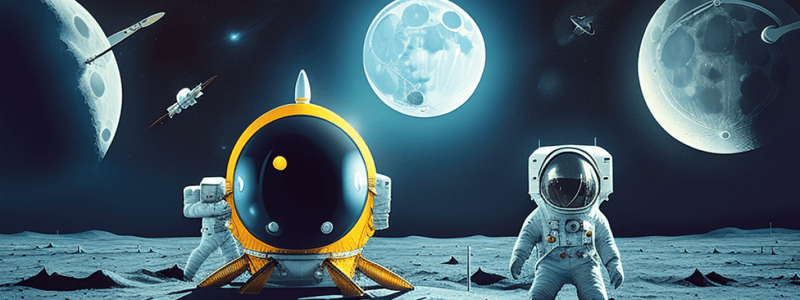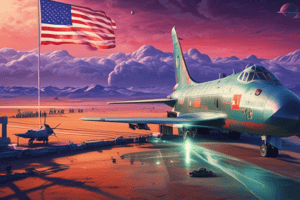Podcast
Questions and Answers
What is the capital of France?
What is the capital of France?
- Berlin
- Madrid
- Paris (correct)
- London
What is the largest planet in our solar system?
What is the largest planet in our solar system?
- Jupiter (correct)
- Venus
- Mars
- Saturn
What is the formula for water?
What is the formula for water?
- H2O (correct)
- H2SO4
- H2O2
- CO2
Which continent is the largest by land area?
Which continent is the largest by land area?
What is the smallest country in the world?
What is the smallest country in the world?
Flashcards
What was the Space Race?
What was the Space Race?
A 20th-century competition between the US and USSR to achieve superior spaceflight capability, rooted in the nuclear arms race.
What was Sputnik 1?
What was Sputnik 1?
The first artificial satellite, launched by the USSR on October 4, 1957, sparking concern in the US.
Who was Yuri Gagarin?
Who was Yuri Gagarin?
On April 12, 1961, he became the first human in space, orbiting Earth in Vostok 1.
What was the Apollo program?
What was the Apollo program?
Signup and view all the flashcards
What was the Apollo–Soyuz Test Project (ASTP)?
What was the Apollo–Soyuz Test Project (ASTP)?
Signup and view all the flashcards
Study Notes
US-USSR spaceflight capability rivalry:
-
The Space Race was a 20th-century competition between the US and the USSR to achieve superior spaceflight capability, which had its origins in the ballistic missile-based nuclear arms race between the two nations following World War II.
-
The Space Race brought pioneering launches of artificial satellites, robotic space probes to the Moon, Venus, and Mars, and human spaceflight in low Earth orbit and ultimately to the Moon.
-
Public interest in space travel originated in the 1951 publication of a Soviet youth magazine and was promptly picked up by US magazines.
-
The competition began on July 30, 1955, when the US announced its intent to launch artificial satellites for the International Geophysical Year. The Soviet Union responded by declaring they would also launch a satellite "in the near future".
-
The competition gained Western public attention with the "Sputnik crisis", when the USSR achieved the first successful satellite launch, Sputnik 1, on October 4, 1957.
-
Gagarin's flight led US president John F. Kennedy to raise the stakes on May 25, 1961, by asking the US Congress to commit to the goal of "landing a man on the Moon and returning him safely to the Earth" before the end of the decade.
-
The USSR pursued two crewed lunar programs but did not succeed with their N1 rocket to launch and land on the Moon before the US, and eventually canceled it to concentrate on Salyut, the first space station program, and the first time landings on Venus and on Mars.
-
A period of détente followed with the April 1972 agreement on a co-operative Apollo–Soyuz Test Project (ASTP), resulting in the July 1975 rendezvous in Earth orbit of a US astronaut crew with a Soviet cosmonaut crew and joint development of an international docking standard APAS-75.
-
Although Americans believed the Moon landing goal was the singular achievement overshadowing all Soviet achievements, such an opinion is generally contentious, with others attributing the first man in space as being a much larger achievement.
-
The Soviet space program's use of secrecy served as both a tool to prevent the leaking of classified information between countries and also to create a mysterious barrier between the space program and the Soviet populace.
-
The Soviet military maintained control over the space program, and Korolev's OKB-1 design bureau was subordinated under the Ministry of General Machine Building, tasked with the development of intercontinental ballistic missiles.
-
Initially, President Eisenhower was worried that a satellite passing above a nation at over 100 kilometers (62 mi) might be seen as violating that nation's airspace.
-
On September 20, 1956, von Braun and his team did launch a Jupiter-C that was capable of putting a satellite into orbit, but the launch was used only as a suborbital test of reentry vehicle technology.Title: The Space Race: Soviet and US Achievements
-
The Soviet Union expedited its plans to launch a satellite after mistakenly thinking that the US had failed in its 1956 Jupiter-C test mission.
-
The Soviet Object D was designed to be the primary satellite and had a weight of 1,400 kg, much heavier than the proposed US satellites.
-
However, the design and manufacturing of Object D faced difficulties, so the simpler Prosteishy Sputnik was created in February 1957.
-
Sputnik 1 was launched on October 4, 1957, using a modified R-7 rocket and weighed less than 200 pounds. It transmitted beeping sounds to indicate its first orbit.
-
The US was concerned about the Soviet success and expedited plans for project Vanguard to launch its own satellite, which resulted in the December 6, 1957 launch failure.
-
On January 31, 1958, the US launched its first successful satellite, Explorer 1, on a four-stage Juno I rocket.
-
The Soviet Luna program focused on lunar probes and had one successful impactor and one successful flyby out of six and three attempts, respectively.
-
The US Ranger program had three successful impactors out of nine attempts.
-
The US and the USSR sent animals, such as dogs and monkeys, into space to test the safety of the environment before humans.
-
The Soviet Vostok program designed a spherical descent module and a biconic instrument module for human spaceflight and revealed the true appearance of the Vostok capsule in 1965.
-
On April 12, 1961, Soviet cosmonaut Yuri Gagarin became the first human in space on the Vostok 1 mission, orbiting Earth once.
-
On May 5, 1961, American astronaut Alan Shepard became the first American in space on the Mercury-Redstone 3 mission, making a suborbital flight.The Space Race: Key Events and Achievements
-
On April 12, 1961, Yuri Gagarin became the first human to orbit the Earth in the Soviet Union's Vostok 1 spacecraft.
-
Gagarin became a national hero and April 12 was declared Cosmonautics Day in the USSR, and later the International Day of Human Space Flight by the United Nations.
-
The USSR launched two piloted spacecraft, Vostok 3 and Vostok 4, in essentially identical orbits in August 1962, which drifted as far apart as 2,850 kilometers.
-
Valentina Tereshkova became the first woman in space on Vostok 6 on June 16, 1963, as part of a medical experiment.
-
The US Air Force's Man in Space Soonest program was transferred to NASA as Project Mercury, with astronaut candidates selected from Navy, Air Force, and Marine test pilots.
-
Alan Shepard became the first American in space on May 5, 1961, on a ballistic trajectory on Mercury-Redstone 3.
-
John Glenn became the first American to orbit the Earth on February 20, 1962, completing three orbits in the Friendship 7 spacecraft.
-
Kennedy initially rejected NASA's budget request for a Moon landing before 1970, but after Gagarin's flight, he proposed the Apollo program to Congress on May 25, 1961.
-
Sergei Khrushchev claimed that his father, Soviet Premier Nikita Khrushchev, was poised to accept Kennedy's proposal for a joint US-USSR lunar landing before Kennedy's assassination on November 22, 1963.
-
The US announced Project Gemini in January 1962, a two-person spacecraft that would support the later three-person Apollo by developing key spaceflight technologies.
-
The USSR's Voskhod spacecraft beat Gemini in achieving the first spaceflight with a multi-person crew and the first spacewalk, with Voskhod 1 on October 12, 1964, and Voskhod 2 on March 18, 1965, respectively.The Space Race: A Look at the Soviet and American Space Programs
-
The Soviet Union launched the first satellite, Sputnik 1, on October 4, 1957, which sparked the Space Race between the Soviet Union and the United States.
-
The Soviet Union sent the first human, Yuri Gagarin, into space on April 12, 1961, while the United States sent Alan Shepard on a suborbital flight on May 5, 1961.
-
The Soviet Union launched the first woman, Valentina Tereshkova, into space on June 16, 1963, while the United States sent the first American woman, Sally Ride, into space on June 18, 1983.
-
The Soviet Union launched the first crew of three, Voskhod 1, on October 12, 1964, while the United States launched the first crew of two, Gemini 3, on March 23, 1965.
-
The Soviet Union launched the first spacewalk, by Alexei Leonov on Voskhod 2 on March 18, 1965, while the United States completed the first docking of two spacecraft, Gemini 8, on March 16, 1966.
-
The Soviet Union's lunar landing program, N1/L3, suffered from technical difficulties, including two launch failures and a launch pad explosion, and was ultimately canceled in 1974 without a successful landing.
-
The United States successfully landed humans on the Moon on July 20, 1969, during the Apollo 11 mission, with Neil Armstrong becoming the first human to walk on the Moon.
-
The United States continued its Apollo program until 1972, with six successful Moon landings and a total of twelve astronauts walking on the Moon.
-
The Soviet Union continued its space program with its Soyuz spacecraft, which is still in use today, and the Mir space station, which operated from 1986 to 2001.
-
The United States continued its space program with the Space Shuttle program, which operated from 1981 to 2011, and the International Space Station, which has been continuously occupied since 2000.
-
The United States and the Soviet Union signed the Outer Space Treaty on January 27, 1967, which created guidelines for the peaceful exploration and use of outer space.
-
Both the United States and the Soviet Union faced setbacks and tragedies during their space programs, including the Apollo 1 fire in 1967 and the Soyuz 1 crash in 1967.
-
The Space Race between the United States and the Soviet Union marked a significant period of technological advancement and competition during the Cold War.
Studying That Suits You
Use AI to generate personalized quizzes and flashcards to suit your learning preferences.




